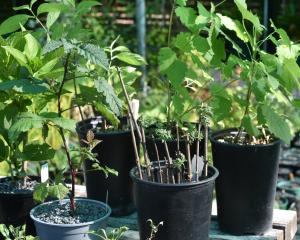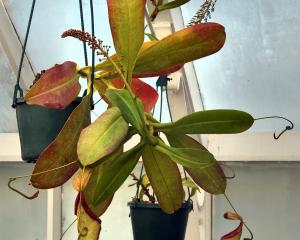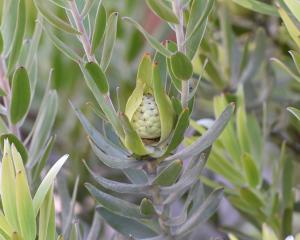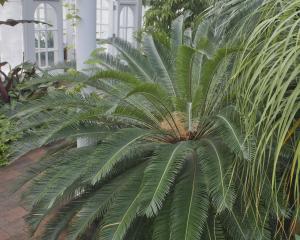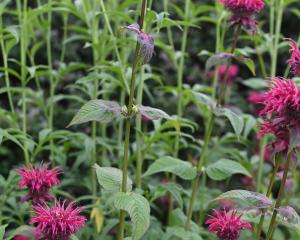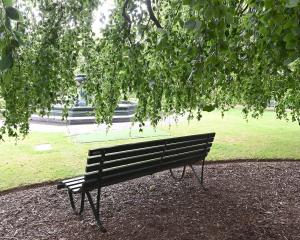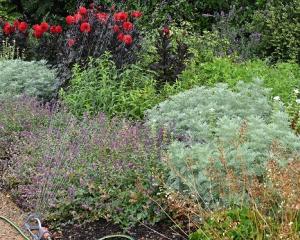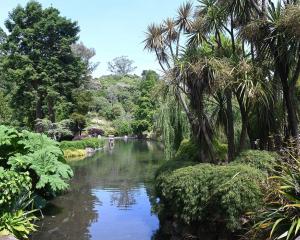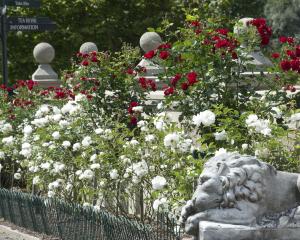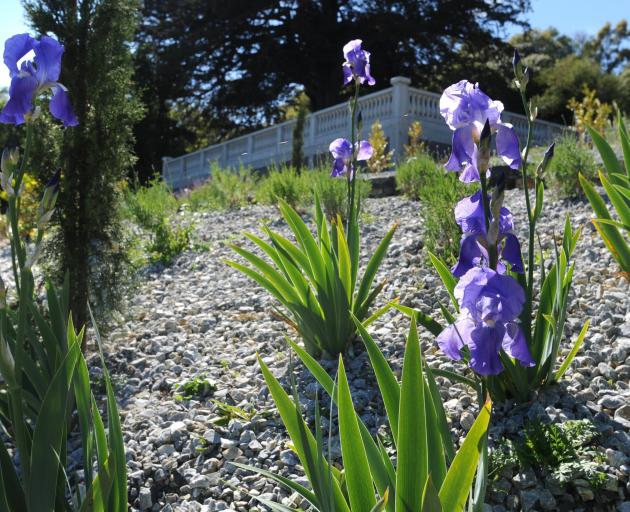
About 12 years ago, Dunedin Botanic Garden rose garden curator Linda Hellyer decided to investigate going green.

Even without the help of these aids, reducing chemical use has relied on building a healthy garden, strong enough to resist disease.
Firstly, choice of rose: only virus-free roses are used and their strength is reviewed annually. To keep fresh air circulating, they’re planted a good distance apart.
Secondly, good garden hygiene: dropped petals and leaves are raked away before they create an environment to host pests and diseases.
Thirdly, a tough system: the rose garden is kept well watered and thoroughly fertilised, resulting in a robust environment — it’s much like a healthy person who doesn’t catch cold.
Natural manure is used for fertiliser, in the past couple of years in the form of organic sheep pellets. They work just as well as chemical products, but the smell is a disadvantage. To dampen down the effects, Linda tries to spread fertiliser on a day followed by forecast rain or before composting, which literally covers the smell.
In future, we might move to a fertiliser with a liquid base, such as seaweed, but this could cause a whole different type of natural smell.
Instead of chemical weedkiller, for the past year Linda has been trialling an organic one made from plant-derived fatty acids. Rather than being absorbed by the plant’s whole system, it burns exposed leaves on contact, acting within a few hours of application.
This means that compared with chemical killers, it has reduced longevity so needs to be applied early in the growing season, regularly and often; in fact, every week at the rose garden.
Although it isn’t as effective on larger weeds, it suits the shallow-rooted weeds that appear in the rose garden just fine.
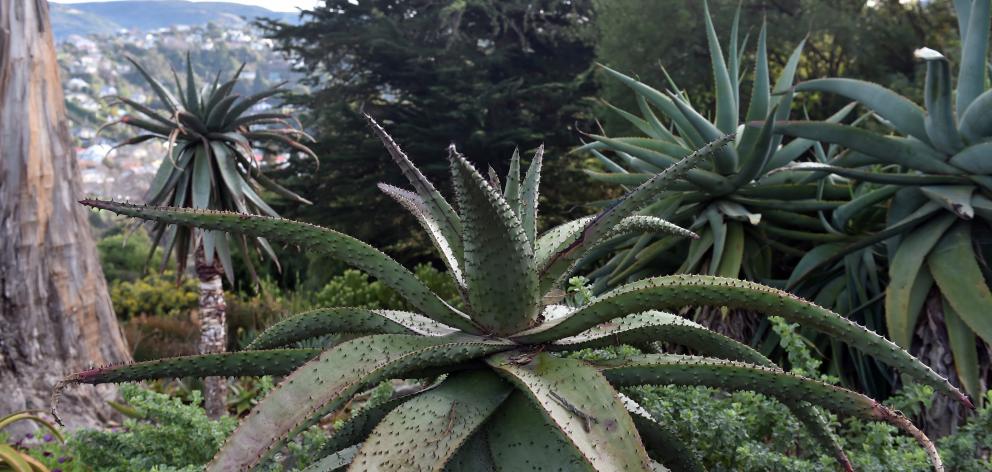
Chemical spraying on the rose garden paths has been pulled back to only glyphosate, the lowest-toxicity chemical spray available. Use is more targeted and considered. Other councils through the country are moving away from glyphosate and some are already completely free of it.
"We have to go down the organic line," says collection supervisor Dylan Norfield.
"There’s a drive for this in society and we need to set a good example. At some point we all have to move that way and we have to accept the consequences."
One consequence is the fact that organic products are about 30 to 40 times more expensive than chemical sprays. Nor are they generally available in the bulk quantities required by a botanic garden. However, as demand increases, these problems should reduce.
Another consequence is that perennials grow back more quickly than when sprayed with chemicals. Weeds need to be sprayed twice as often, which means paths being closed to visitors twice as often. Potentially, the growth could be tackled by increased hand weeding, hoeing or mulching. But all this extra work requires extra time and person-power, which means the need for more staff and the funding to pay for them.
A further option is to accept that flaws are part of nature and simply enjoy a plant for its overall beauty. Like tolerating a blemish on an organic apple, maybe imperfection is a price worth paying.
In future we’ll continue to experiment.
Garlic and pyrethrum spray might work for strong infestations of aphids in hot summers. A plant soap to smother aphids is a possibility showing promise elsewhere.
For smaller-scale problems, the worst of a plant’s affected areas can be picked off by hand. The whole thing’s an evolving situation and we’ll continue to do our best to get things right.

In the bad old days, wood prunings were removed for disposal, then we’d buy in new mulch. These days, rotting or small waste wood is chipped on site. It’s returned to the ecosystem in the bush or on plant beds as a mulch that’s just as effective as pea straw.
IN the process we’re saving about $10,000 a year through needing less pea straw from Ashburton, let alone the carbon miles. If the wood’s too good a quality for chipping, the Malcam Trust supplies it as firewood to local people who need help.
Compost is made on site now too, but only on a small scale. If there were the time, space and machinery, mountains of the stuff could be produced from the amount of green waste a botanic garden produces.
What is produced currently is a low-quality product with visibly undecomposed material, but it can still be used as a "filling" rather than "finishing" material in highly visual areas. We just need to pick the spot. For example, it wouldn’t be spread on the delicately cultivated rose garden, but was perfect for bulking up beds in the new Mediterranean garden, which were then topped with a layer of gravel. Borders surrounding the upper garden car park are composted with this material made only 100m away, and then covered with a flattering bark chip.
The garden is well positioned for the sun and in summer is a sheltered hot spot. In a dry year, staff can spend many cumulative hours installing and shifting sprinklers so, over time, reducing watering has had benefits for the organisation as well as being environmentally sound.
A lot of the trick here was plant collection curators building up such good knowledge of the garden they could select at the planning stage plants that would survive each dry spot with minimal watering.
Needless to say, the Southern African garden, Mediterranean garden and Australian borders have never been watered, due to the plants’ natural toughness. Drought-tolerant plants are not the ultimate answer, though, because part of the brief of a botanic garden is to display a wide representation of plant diversity.
Use of peat is another area that has recently been reviewed. A whole section of the Rhododendron Dell has been built on it, the peat garden, but we know now that peat’s extraction from nature is not sustainable.
This dense material is formed very slowly over many years by the partial decomposition of plants and, like coal, is considered a non-renewable fuel source (some people burn it for warmth).
As a growing medium, it’s sterile and hosts no weeds, has high water-holding properties and is fibrous and open, so is easy for roots to penetrate. In fact, it is pure fibre with no nutrients, which means a gardener can add fertiliser and get precision control over nutrient levels. But it forms at the rate of only about 1mm a year.
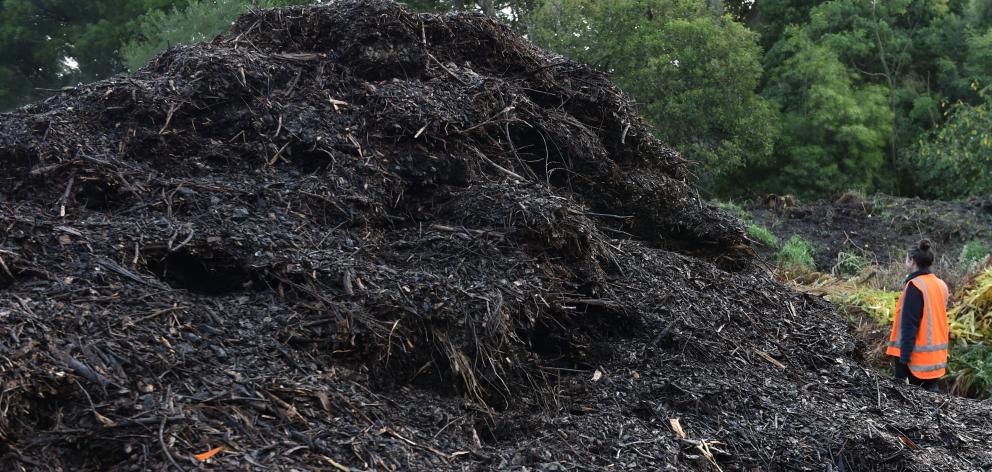
The coconut fibre is proving more gritty and granular, so is likely to dry out faster. It is also a lighter colour, resulting in the plants standing out less effectively than against the darker peat. Other gardens have found coco peat breaks down faster than peat and needs more frequent replacement. But the natural peatland ecosystem is conserved in the wild and that is the most important thing.
Trial plants have responded well, so the plan is to start using coco peat more widely throughout the peat garden.
Management of indoor plants is another field that requires some thoughtful decision-making. They’re vulnerable to attack from pest insects that also thrive in the warmth. To minimise the amount and toxicity of chemicals sprayed in the propagation unit and winter garden glasshouse, we practise integrated pest management, a combination of biological, cultural and chemical control.
BIOLOGICAL control involves using the pest’s natural enemies to fight them and is the cornerstone of the integrated pest management programme. Predatory insects and parasites, often native to the pest’s home country, are introduced at specific times of the pest’s life cycle to control pests such as mealy bug, aphids, thrips, white fly and caterpillars, and even the soil-dwelling scarid fly and root mealy.
Cultural control means creating the least ideal environment for pests and a more favourable environment for their predators. For example, raised humidity discourages the spider mite and encourages its natural predator, Phytoseiulus persimilis, which likes the damp. Allowing for good air movement reduces infestations in the first place and is achieved through decent spacing between plants and through regular pruning. Infestations can be physically pruned out too, or just a whole host weed removed.
Like the rose garden, a fundamental tool is to keep plants in good health so they’re less susceptible to pest infestations and an important part of this is keeping the area tidy of fallen leaves that can provide shelter for pests.
Chemical control still has to be done sometimes. Pesticides are selected to cause minimal disturbance to beneficial pests. For example, some chemicals are able to target only certain pest species or just interfere with a pest’s life cycle. Stronger chemicals are used only as a last resort.
Back outside, there’s more we’re doing. As well as distributing pruned wood for those who need help heating their houses, Malcam Trust has a contract with the garden for training young workers in lawnmowing and hard-surface maintenance. As well as providing paid work experience for young adults, this scheme has reduced the need for machinery, as the paths are no longer gravelled by machinery but by hand. If society decides we do, in fact, want minimal chemical use, perhaps this return to doing things by hand will be a theme of the future.
Native bush at the botanic garden has also been the recent recipient of increased person power. It covers a surprisingly large portion of the garden, about one quarter, and these big green lungs are a real asset to the garden and city. As part of the Town Belt, the bush contributes to the ecological corridor used by birds flying from one spot to another. Over the years, however, it hasn’t received the same attention as the more labour-intensive horticultural displays.
It’s practically all regrowth, the original forest having been cleared. Invasive introduced plants are always ready for an opportunity and during the regrowth period jumped at the chance to get in quickly before the natives had a chance to regrow. As a result, parts of the botanic garden bush are quite weedy.
Although the regrowth is more than 100 years old, these are still early years ecologically. Natives are certainly growing, but if left unmanaged the bush could gradually veer in an unhealthy direction and end up dominated by weedy non-native species.
The importance of weed removal in the Town Belt cannot be overstated. A 2006 ecological report on the Town Belt, by Wildland Consultants, concluded:
"Weed control is the management issue of prime importance if the ecological values of the Town Belt are to be sustained. Regeneration of locally native canopy tree species is being inhibited across wide areas of the Town Belt. Without effective weed control, the medium to long-term outcome will be collapse of the native forest canopy. This will have the additional effect of removing potential seed sources by which locally native species could regenerate in the absence of heavy weed infestations. The result will be complete domination of the Town Belt forests by exotic and non-local plants."
THESE are pivotal years.
For the past five or so years, gardening staff have banded together each winter to attack the pest plants. Once a week, staff scour the bush, sometimes on quite steep slopes, for species such as ivy, sycamore, old man’s beard and aluminium weed. Each species requires different treatment, but a common component is, if possible, leaving the dead plant on site to rot and return its nutrients to the ecosystem. For particularly tenacious species, this can mean hanging them up high in the fork of a tree so the roots will completely dry out and not sprout further progeny.
Mature sycamores on steep slopes are very tricky to fell safely, so last year some in the hillside bush between the Rhododendron Dell and Water of Leith were chemically ringbarked as an experiment. While the foliage has died off, the trees are likely to re-sprout after only one chemical ring bark spray. It can take three treatments before they die, so we’ll do a second one in autumn and see how that goes. The eventual aim is for the dead trees to be left to decompose naturally over time.
As each year passes, staff are finding their hard work is paying long-term dividends in a satisfyingly healthy forest floor, free to host native seedlings. Keeping it clear of invasive plants is an ongoing job, but this bush is potentially here for many hundreds of years.
So there’s been a lot of restorative action over the past few years to try to get greener on-site. The garden also has a role in helping conserve nature in the wild.
Rare native plants are grown in the propagation unit as backup for outdoor conservation efforts. Lepidium banksii is rare in the wild and a network of people throughout the country are working to help the Department of Conservation (Doc) save it. The botanic garden is growing seed from wild-collected samples, then sending it back for Doc to use in restoration projects. It’s otherwise known as edible peppercress and specimens are on display in the legume border of the garden’s native plant collection.
Another plant is being helped here too, this one from the Far North. Bartlett’s rata, Metrosideros bartlettii, was discovered by a schoolteacher in 1975 and there are only 13 adult trees known in the wild. The botanic garden’s propagation unit is growing seedlings from plant material originally collected from the wild trees. They’re being grown in perpetuity until required by iwi and Doc so potentially could spend all their life in the propagation unit as money in the bank. But what an investment.
Like all the other efforts described, it’s about doing our best. We know we can do a lot more, but these are the first steps in that direction. Dunedin Botanic Garden won’t be able to save the natural environment alone, but we have to take responsibility for doing our share.
- Clare Fraser manages adult education at Dunedin Botanic Garden.
Comments
How about making a business out of mulching and compost? As the article says- there is plenty of material around, and a good way to reduce our rates.
Comment from Clare Fraser:
We have none of these resources available to us to do any more than what we produce now. To do anything else would require additional expenditure.




